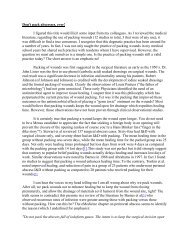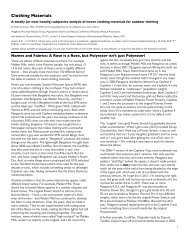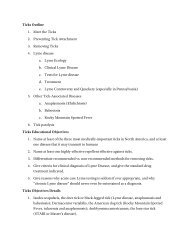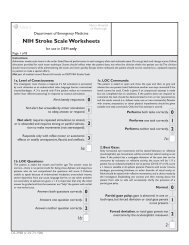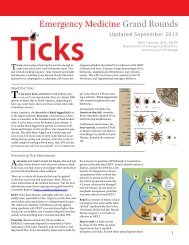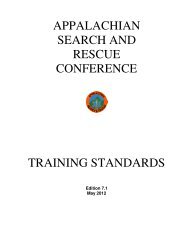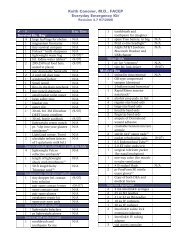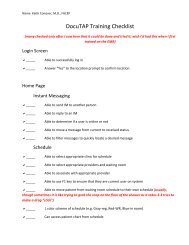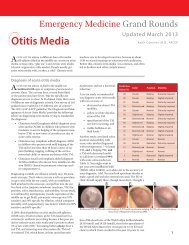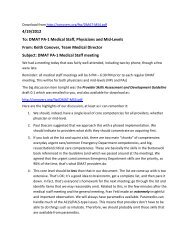pneumothorax BTS guidelines for the management of spontaneous
pneumothorax BTS guidelines for the management of spontaneous
pneumothorax BTS guidelines for the management of spontaneous
Create successful ePaper yourself
Turn your PDF publications into a flip-book with our unique Google optimized e-Paper software.
Downloaded from thorax.bmj.com on 17 August 2008<br />
<strong>BTS</strong> <strong>guidelines</strong> <strong>for</strong> <strong>the</strong> <strong>management</strong> <strong>of</strong> <strong>spontaneous</strong> <strong>pneumothorax</strong><br />
ii47<br />
persistent air leaks had resolved <strong>the</strong>ir air leaks by 14 days with<br />
no mortality. However, considering <strong>the</strong> efficacy and relatively<br />
low levels <strong>of</strong> morbidity and recurrence associated with surgery<br />
<strong>for</strong> <strong>pneumothorax</strong>, 109–112 earlier surgical intervention has been<br />
advocated <strong>for</strong> persistent air leak or failure <strong>of</strong> re-expansion,<br />
particularly in cases <strong>of</strong> secondary <strong>pneumothorax</strong>. 92 113 Several<br />
authors have recommended operative referral/intervention as<br />
early as 3 days <strong>for</strong> a persistent air leak. However, <strong>the</strong>se studies<br />
were not controlled. 91 93 Despite <strong>the</strong> reduction in <strong>the</strong> incidence<br />
<strong>of</strong> late recurrence <strong>of</strong> <strong>pneumothorax</strong> in many <strong>of</strong> <strong>the</strong>se studies,<br />
surgical referral <strong>for</strong> a persistent air leak in a first primary<br />
<strong>pneumothorax</strong> within <strong>the</strong> first 4–5 days is not supported by<br />
<strong>the</strong> literature. However, best practice suggests that protracted<br />
chest tube drainage is not in <strong>the</strong> patient’s interest. It is <strong>the</strong>re<strong>for</strong>e<br />
recommended that patients with difficult pneumothoraces<br />
should receive care from a respiratory physician and that a<br />
thoracic surgical opinion will be an early part <strong>of</strong> <strong>management</strong>.<br />
According to <strong>the</strong> statistical and perceived risk <strong>of</strong> recurrence,<br />
accepted indications <strong>for</strong> operative intervention are as follows:<br />
• Second ipsilateral <strong>pneumothorax</strong><br />
• First contralateral <strong>pneumothorax</strong><br />
• Bilateral <strong>spontaneous</strong> <strong>pneumothorax</strong><br />
• Persistent air leak (>5–7 days <strong>of</strong> tube drainage; air leak or<br />
failure to completely re-expand)<br />
• Spontaneous haemothorax<br />
108 110 114–116<br />
• Pr<strong>of</strong>essions at risk (e.g. pilots, divers)<br />
4.5.1 Surgical strategies<br />
There are two objectives in <strong>the</strong> surgical <strong>management</strong> <strong>of</strong> a<br />
<strong>pneumothorax</strong>. The first widely accepted objective is resection<br />
<strong>of</strong> blebs or <strong>the</strong> suture <strong>of</strong> apical per<strong>for</strong>ations to treat <strong>the</strong> underlying<br />
defect. The second objective is to create a pleural<br />
symphysis to prevent recurrences. There is debate between<br />
those who favour surgical pleurodesis or pleural abrasion versus<br />
those who favour partial or total pleurectomy as a definitive<br />
treatment to prevent recurrence <strong>of</strong> <strong>pneumothorax</strong>,<br />
109 117 118<br />
although a relatively recent comprehensive review <strong>of</strong> this area<br />
suggests a slight advantage <strong>of</strong> pleurectomy over pleural abrasion<br />
with a recurrence rate <strong>of</strong> 0.4% after pleurectomy (n=752)<br />
and 2.3% after pleural abrasion (n=301). 109<br />
Operative techniques<br />
have tended towards minimally invasive procedures<br />
over <strong>the</strong> last few years. In order to be considered effective,<br />
<strong>the</strong>se techniques should yield results comparable to <strong>the</strong> “gold<br />
standard” open thoracotomy procedure—that is, <strong>the</strong> operative<br />
morbidity should be less than 15% and <strong>the</strong> <strong>pneumothorax</strong><br />
37 99 112<br />
recurrence rate should be less than 1%.<br />
Open thoracotomy<br />
In 1941 Tyson and Crandall 119 described pleural abrasion as a<br />
treatment <strong>for</strong> <strong>pneumothorax</strong> and in 1956 Gaensler 117<br />
introduced<br />
parietal pleurectomy <strong>for</strong> recurrent <strong>pneumothorax</strong>. This<br />
procedure produces uni<strong>for</strong>m adhesions between <strong>the</strong> pleura<br />
and <strong>the</strong> chest wall. Both <strong>of</strong> <strong>the</strong>se techniques are designed to<br />
obliterate <strong>the</strong> pleural space by creating symphysis between <strong>the</strong><br />
two pleural layers or between <strong>the</strong> visceral pleura and subpleural<br />
plane, in <strong>the</strong> case <strong>of</strong> parietal pleurectomy. In order to prevent<br />
recurrence, however, an appropriate closure at <strong>the</strong> site <strong>of</strong><br />
<strong>the</strong> pleural air leak is essential ei<strong>the</strong>r by cauterisation, ligation,<br />
or suture <strong>of</strong> accompanying blebs. 116 Open thoracotomy yields<br />
<strong>the</strong> lowest postoperative recurrence results. Bulla ligation/<br />
excision, thoracotomy with pleural abrasion, and ei<strong>the</strong>r apical<br />
or total parietal pleurectomy all have failure rates under<br />
0.5%. 48 110 Morbidity from thoracotomy <strong>for</strong> <strong>pneumothorax</strong> has<br />
an overall incidence <strong>of</strong> 3.7%, mostly in <strong>the</strong> <strong>for</strong>m <strong>of</strong> sputum<br />
retention and postoperative infection. 110 Open thoracotomy is<br />
generally per<strong>for</strong>med using single lung ventilation, a limited<br />
posterolateral thoracotomy allowing parietal pleurectomy,<br />
excision, or stapling <strong>of</strong> bullae or pleural abrasion. 120 Isolated<br />
lung ventilation during open thoracotomy facilitates full visualisation<br />
<strong>of</strong> <strong>the</strong> visceral pleura. This may not be possible during<br />
a VATS procedure, increasing <strong>the</strong> risk <strong>of</strong> missing a leaking<br />
bulla. 121–123<br />
Open thoracotomy may be associated with increased<br />
postoperative respiratory dysfunction and hospital<br />
stay compared with VATS procedures. 120 It is suggested that <strong>the</strong><br />
success rates with <strong>the</strong> open procedure are higher. 124 Thus, surgical<br />
authorities suggest open thoracotomy in patients with<br />
secondary pneumothoraces who may have extensive pleural<br />
disease requiring more extensive pleurectomy, subpleural<br />
110 114 125<br />
bullectomy, or pleural abrasion.<br />
Surgical chemical pleurodesis<br />
• Surgical chemical pleurodesis is best achieved with<br />
5 g sterile talc. Side effects such as ARDS and<br />
empyema are reported but rare. [A]<br />
The use <strong>of</strong> talc pleurodesis is now a subject <strong>of</strong> renewed interest<br />
because <strong>of</strong> <strong>the</strong> potential unavailability <strong>of</strong> tetracycline, its<br />
low cost, and a record <strong>of</strong> successful pleurodesis (85–92%) that<br />
is similar to alternative thoracoscopic techniques <strong>for</strong> complicated<br />
<strong>pneumothorax</strong>. 99 114 126 127 While talc slurry inserted under<br />
medical supervision via intercostal tube drainage tends to be<br />
less favoured than thoracoscopic talc poudrage, both methods<br />
have been shown to be effective. The overall success rate <strong>for</strong><br />
talc pleurodesis reviewed by meta-analysis is 91%. 126 Surgical<br />
pleurodesis with tetracycline is not generally felt to be a satisfactory<br />
alternative, with recurrence rates <strong>of</strong> 16% in a series <strong>of</strong><br />
390 patients who underwent surgical pleurodesis using<br />
tetracycline. 98<br />
There are no controlled trials comparing pain<br />
during talc pleurodesis with that using o<strong>the</strong>r agents, although<br />
it is suggested that talc pleurodesis is no more difficult or<br />
painful a procedure than tetracycline pleurodesis. 128–132<br />
Dosages<br />
<strong>of</strong> talc ranging from 2 g to 10 g have been used, but <strong>the</strong><br />
suggestion that higher dosages are more effective has not been<br />
established by controlled trials. On <strong>the</strong> basis <strong>of</strong> a metaanalysis<br />
<strong>of</strong> uncontrolled data, 5 g talc by VATS is recommended<br />
with a success rate <strong>of</strong> 87%, which is very close to <strong>the</strong><br />
success rates using more extensive operative approaches. 126<br />
Side effects reported with talc pleurodesis include five cases <strong>of</strong><br />
adult respiratory distress syndrome (ARDS), although <strong>the</strong> risk<br />
<strong>of</strong> ARDS may be related to <strong>the</strong> size <strong>of</strong> talc particles used 133 ;<br />
empyema, although this is rare when properly sterilised talc is<br />
used 126 134 135 ; pneumonia; and respiratory failure. 134 In view <strong>of</strong><br />
<strong>the</strong>se potential side effects, standard first line usage <strong>of</strong> talc<br />
poudrage or talc slurry pleurodesis should be approached with<br />
caution since surgery not dependent on introducing a <strong>for</strong>eign<br />
agent is usually an option. Lower dosages <strong>of</strong> 2–5 g should be<br />
used until dosage schedules and effectiveness have been clarified.<br />
Long term safety does not appear to be an issue if<br />
asbestos-free talc is used. The success rates with talc poudrage<br />
and talc slurry pleurodesis are similar, so ei<strong>the</strong>r approach can<br />
be recommended. Because <strong>of</strong> <strong>the</strong> relatively high failure rates<br />
<strong>of</strong> over 9% with talc pleurodesis compared with surgical pleural<br />
stripping procedures, talc pleurodesis should not be<br />
considered as initial treatment <strong>for</strong> primary <strong>spontaneous</strong><br />
<strong>pneumothorax</strong> requiring surgical intervention. In those<br />
patients who are ei<strong>the</strong>r unwilling or too unwell to undergo<br />
general anaes<strong>the</strong>sia, medical pleurodesis with ei<strong>the</strong>r tetracycline<br />
or talc (via an intercostal tube) is recommended.<br />
Transaxillary minithoracotomy<br />
Becker and Munro 136 pioneered this technique in <strong>the</strong> 1970s.<br />
The procedure is considered a minimally invasive procedure.<br />
The incision in <strong>the</strong> axillary margin measures 5–6 cm. Apical<br />
pleurectomy or abrasion may be per<strong>for</strong>med and <strong>the</strong> apex carefully<br />
inspected <strong>for</strong> pleural blebs or bullae which may be<br />
stapled. The largest series examining this technique reported<br />
a mean hospital stay <strong>of</strong> 6 days, a recurrence rate <strong>of</strong> 0.4%, and<br />
a complication rate <strong>of</strong> 10%, most <strong>of</strong> which were minor. 125 These<br />
results make this procedure a realistic alternative to open<br />
www.thoraxjnl.com



